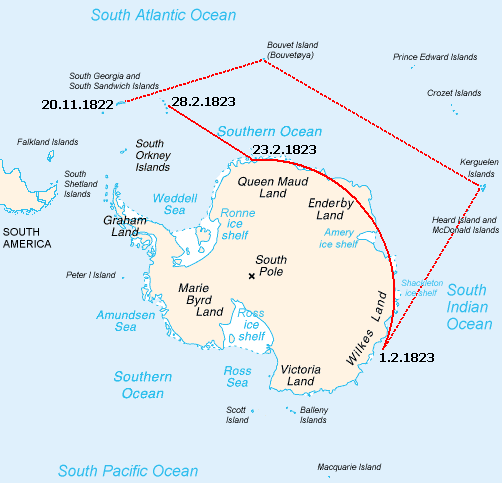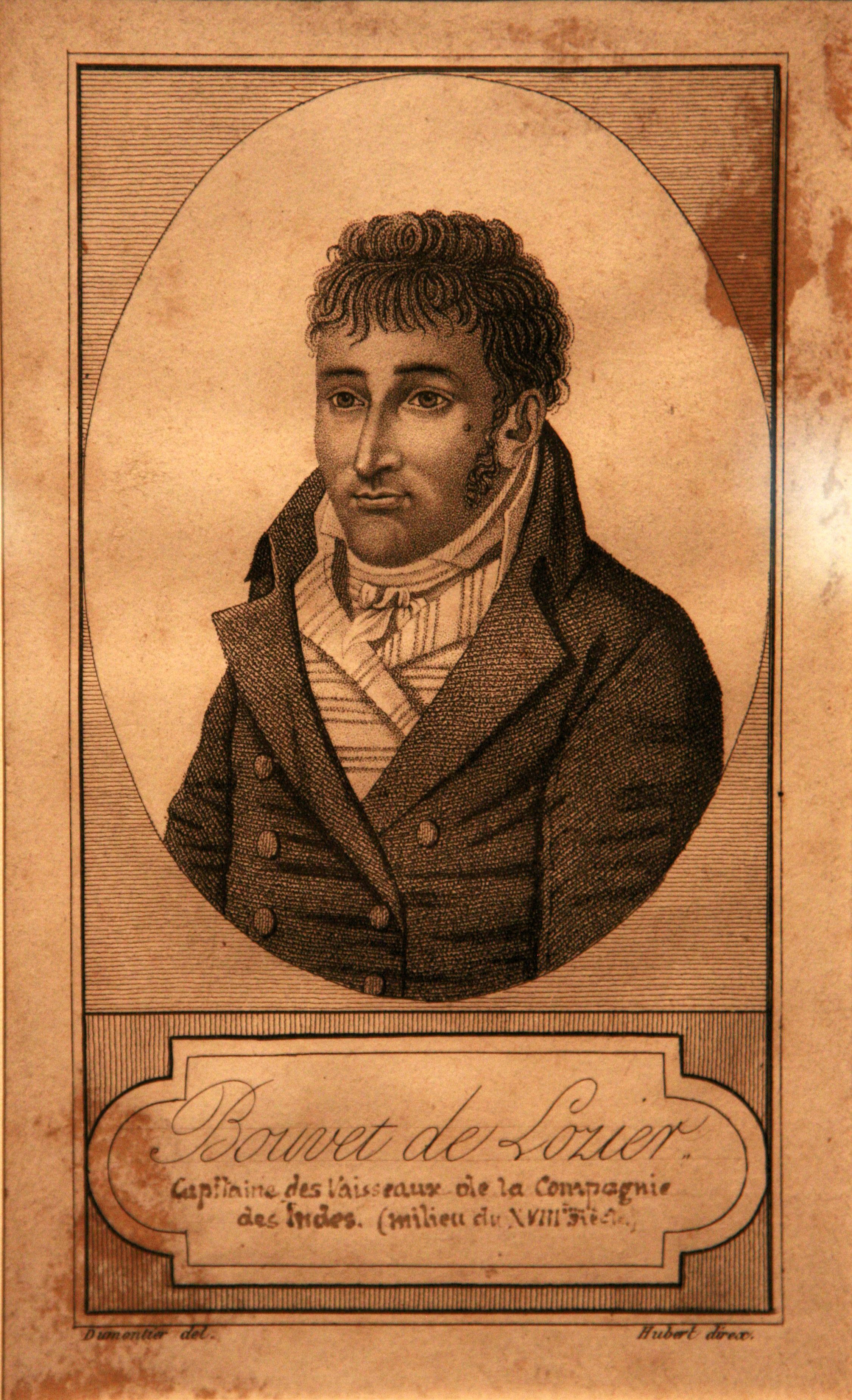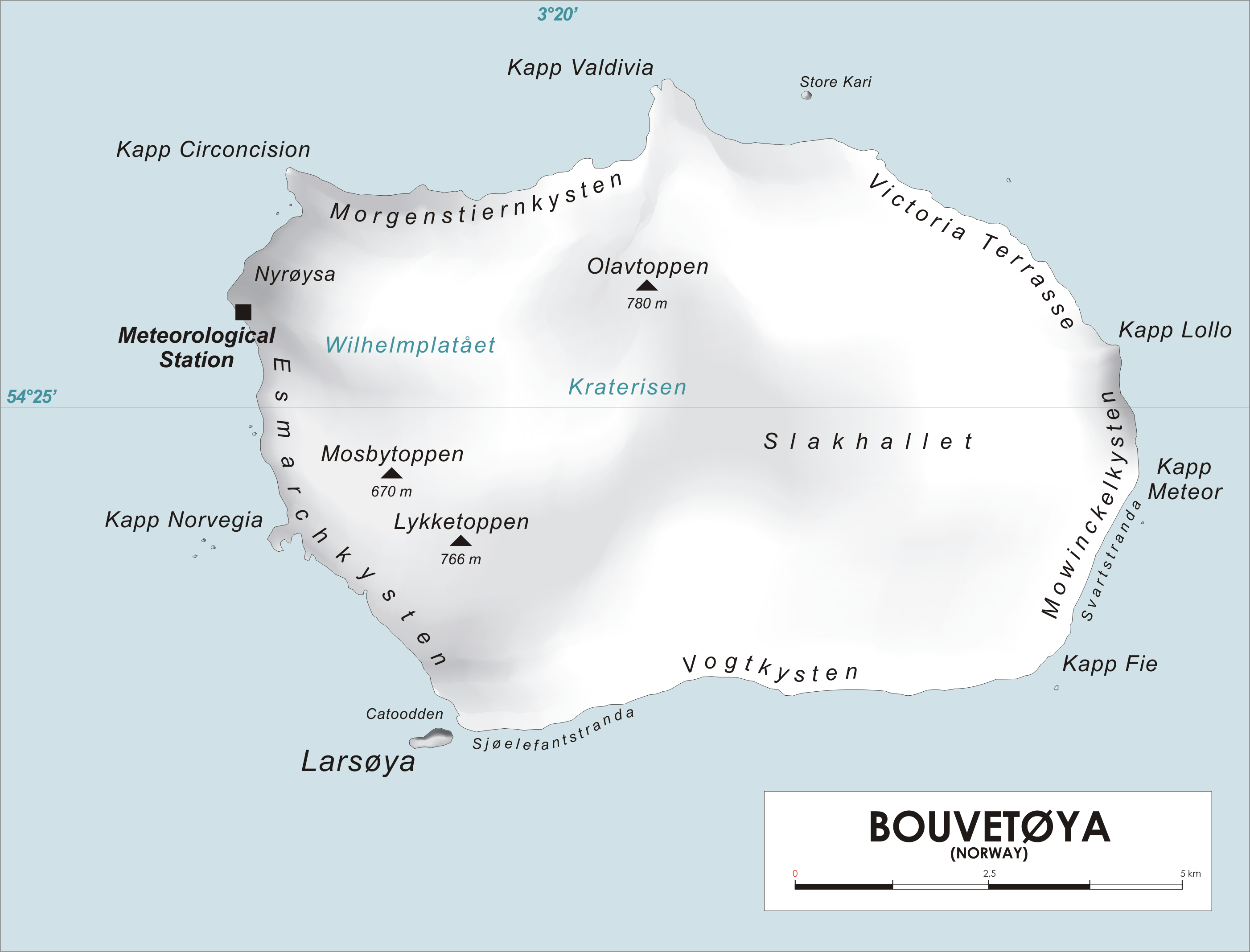|
Bouvet Island
Bouvet Island ( ; ) is an island and dependency of Norway, and declared an uninhabited protected nature reserve. It is a subantarctic volcanic island, situated in the South Atlantic Ocean at the southern end of the Mid-Atlantic Ridge, and is the world's most remote island. It is not part of the southern region covered by the Antarctic Treaty System. The island lies north of the Princess Astrid Coast of Queen Maud Land, Antarctica, east of the South Sandwich Islands, south of Gough Island, and south-southwest of the coast of South Africa. It has an area of , 93 percent of which is covered by a glacier. The centre of the island is the ice-filled crater of an inactive volcano. Some skerries and one smaller island, Larsøya, lie along its coast. Nyrøysa, created by a rock slide in the late 1950s, is the only easy place to land and is the location of a weather station. The island was first spotted on 1 January 1739 by the Frenchman Jean-Baptiste Charles Bouvet de Lo ... [...More Info...] [...Related Items...] OR: [Wikipedia] [Google] [Baidu] |
Dependencies Of Norway
Norway has three dependent territories ( no, biland), all uninhabited and located in the Southern Hemisphere. Bouvet Island (Bouvetøya) is a sub-Antarctic island in the South Atlantic Ocean. Queen Maud Land is a sector of Antarctica which spans between the 20th meridian west and the 45th meridian east. Peter I Island is a volcanic island located off the coast of Ellsworth Land of continental Antarctica. Svalbard is not formally considered to be a dependency. While the Svalbard Treaty regulates some aspects of that Arctic territory, one article acknowledges that these islands are part of Norway. Similarly, Jan Mayen is recognized as an integral part of the nation. Both are unincorporated areas. Both Peter I Island and Queen Maud Land are south of 60°S and are thus part of the Antarctic Treaty System. While the treaty states that the claims are not affected by the treaty, only the other countries with claims recognize Norwegian sovereignty on the island. The dependencies are a ... [...More Info...] [...Related Items...] OR: [Wikipedia] [Google] [Baidu] |
Antarctica
Antarctica () is Earth's southernmost and least-populated continent. Situated almost entirely south of the Antarctic Circle and surrounded by the Southern Ocean, it contains the geographic South Pole. Antarctica is the fifth-largest continent, being about 40% larger than Europe, and has an area of . Most of Antarctica is covered by the Antarctic ice sheet, with an average thickness of . Antarctica is, on average, the coldest, driest, and windiest of the continents, and it has the highest average elevation. It is mainly a polar desert, with annual precipitation of over along the coast and far less inland. About 70% of the world's freshwater reserves are frozen in Antarctica, which, if melted, would raise global sea levels by almost . Antarctica holds the record for the lowest measured temperature on Earth, . The coastal regions can reach temperatures over in summer. Native species of animals include mites, nematodes, penguins, seals and tardigrades. Where vegetation o ... [...More Info...] [...Related Items...] OR: [Wikipedia] [Google] [Baidu] |
Thompson Island (South Atlantic)
Thompson Island was a phantom island in the Atlantic Ocean, South Atlantic. It was thought to be about north-northeast of Bouvet Island, a small Norway, Norwegian Dependent territory, dependency between South Africa and Antarctica. History The island was first reported and named by Whaler, whaling ship Sea captain, captain George Norris in 1825, supposedly the same day as sighting and landing on Bouvet Island, erroneously thinking the island to be undiscovered and naming it Liverpool Island. The last reported sighting was in 1893. When, however, the German Empire, German Survey vessel, survey ship ''Valdivia'' fixed the position of Bouvet in 1898, it then looked for Thompson, but did not find it. If Thompson ever existed, it is probable that it disappeared in a Volcano, volcanic eruption sometime in the 1890s, though in 1997 it was reported that the sea depth at the supposed location is greater than , rendering the existence of a submarine volcano all but impossible. Thompson ... [...More Info...] [...Related Items...] OR: [Wikipedia] [Google] [Baidu] |
British Crown
The Crown is the state (polity), state in all its aspects within the jurisprudence of the Commonwealth realms and their subdivisions (such as the Crown Dependencies, British Overseas Territories, overseas territories, Provinces and territories of Canada#Provinces, provinces, or states and territories of Australia, states). Legally ill-defined, the term has different meanings depending on context. It is used to designate the monarch in either a personal capacity, as Head of the Commonwealth, or as the king or queen of their realms (whereas the monarchy of the United Kingdom and the monarchy of Canada, for example, are distinct although they are in personal union). It can also refer to the rule of law; however, in common parlance 'The Crown' refers to the functions of executive (government), government and the civil service. Thus, in the United Kingdom (one of the Commonwealth realms), the government of the United Kingdom can be distinguished from the Crown and the state, in prec ... [...More Info...] [...Related Items...] OR: [Wikipedia] [Google] [Baidu] |
Benjamin Morrell
Benjamin Morrell (July 5, 1795 – 1838 or 1839?) was an American sea captain, explorer and trader who made a number of voyages, mainly to the Atlantic, the Southern Ocean and the Pacific Islands. In a ghost-written memoir, ''A Narrative of Four Voyages'', which describes his sea-going life between 1823 and 1832, Morrell included numerous claims of discovery and achievement, many of which have been disputed by geographers and historians, and in some cases have been proved false. He ended his career as a fugitive, having wrecked his ship and misappropriated parts of the salvaged cargo. Morrell had an eventful early career, running away to sea at the age of 17 and being twice captured and imprisoned by the British during the War of 1812. He subsequently sailed before the mast for several years before being appointed as chief mate, and later as captain, of the New York sealer ''Wasp''. In 1823 he took ''Wasp'' for an extended voyage into subantarctic waters, and on his return made u ... [...More Info...] [...Related Items...] OR: [Wikipedia] [Google] [Baidu] |
Whaler
A whaler or whaling ship is a specialized vessel, designed or adapted for whaling: the catching or processing of whales. Terminology The term ''whaler'' is mostly historic. A handful of nations continue with industrial whaling, and one, Japan, still dedicates a single factory ship for the industry. The vessels used by aboriginal whaling communities are much smaller and are used for various purposes over the course of the year. The ''whale catcher'' was developed during the age of steam, and then driven by diesel engines throughout much of the twentieth century. It was designed with a harpoon gun mounted at its bow and was fast enough to chase and catch rorquals such as the fin whale. At first, whale catchers either brought the whales they killed to a whaling station, a settlement ashore where the carcasses could be processed, or to its factory ship anchored in a sheltered bay or inlet. With the later development of the slipway at the ship's stern, whale catchers were able ... [...More Info...] [...Related Items...] OR: [Wikipedia] [Google] [Baidu] |
South Atlantic
The Atlantic Ocean is the second-largest of the world's five oceans, with an area of about . It covers approximately 20% of Earth's surface and about 29% of its water surface area. It is known to separate the " Old World" of Africa, Europe and Asia from the "New World" of the Americas in the European perception of the World. The Atlantic Ocean occupies an elongated, S-shaped basin extending longitudinally between Europe and Africa to the east, and North and South America to the west. As one component of the interconnected World Ocean, it is connected in the north to the Arctic Ocean, to the Pacific Ocean in the southwest, the Indian Ocean in the southeast, and the Southern Ocean in the south (other definitions describe the Atlantic as extending southward to Antarctica). The Atlantic Ocean is divided in two parts, by the Equatorial Counter Current, with the North(ern) Atlantic Ocean and the South(ern) Atlantic Ocean split at about 8°N. Scientific explorations of the Atlanti ... [...More Info...] [...Related Items...] OR: [Wikipedia] [Google] [Baidu] |
Jean-Baptiste Charles Bouvet De Lozier
Jean-Baptiste Charles Bouvet de Lozier (14 January 1705 – 1786) was a French sailor, explorer, and governor of the Mascarene Islands. He was orphaned at the age of seven and after being educated in Paris, he was sent to Saint Malo to study navigation. He became a lieutenant of the French East India Company in 1731. He succeeded in convincing his employer to provide him with two ships and send him on an exploration mission in the South Atlantic. With his ships ''Aigle'' and ''Marie'' he discovered on 1 January 1739 a tiny island which was named Bouvet Island after him; however, he mislabeled the coordinates for the island, causing it to be lost until it was rediscovered seven decades later in 1808. Shortly afterwards, he had to abandon the expedition because most of his crew had fallen ill; his ship then called at the Cape of Good Hope and returned to France. Ten years after his expedition, Bouvet de Lozier was appointed governor of the Mascarene Islands The Mascarene Islan ... [...More Info...] [...Related Items...] OR: [Wikipedia] [Google] [Baidu] |
Weather Station
A weather station is a facility, either on land or sea, with instruments and equipment for measuring atmospheric conditions to provide information for weather forecasts and to study the weather and climate. The measurements taken include temperature, atmospheric pressure, humidity, wind speed, wind direction, and precipitation amounts. Wind measurements are taken with as few other obstructions as possible, while temperature and humidity measurements are kept free from direct solar radiation, or insolation. Manual observations are taken at least once daily, while automated measurements are taken at least once an hour. Weather conditions out at sea are taken by ships and buoys, which measure slightly different meteorological quantities such as sea surface temperature (SST), wave height, and wave period. Drifting weather buoys outnumber their moored versions by a significant amount. Weather instruments Typical weather stations have the following instruments: * Thermometer for ... [...More Info...] [...Related Items...] OR: [Wikipedia] [Google] [Baidu] |
Larsøya
Larsøya, sometimes anglicized as Lars Island, is a rocky island, less than long, which lies just off the southwestern extremity of the island of Bouvetøya in the South Atlantic Ocean. It was first roughly charted in 1898 by a German expedition under Carl Chun. The Norwegian expedition under Captain Harald Horntvedt made a landing on the island from the ship ''Norvegia'' in December 1927, and named it after Lars Christensen Lars Christensen (6 April 1884 – 10 December 1965) was a Norwegian shipowner and whaling magnate. He was also a philanthropist with a keen interest in the exploration of Antarctica. Career Lars Christensen was born at Sandar in Vestfold, Norw ..., sponsor of the expedition. See also * List of Antarctic and subantarctic islands References Landforms of Bouvet Island {{BouvetIsland-geo-stub ... [...More Info...] [...Related Items...] OR: [Wikipedia] [Google] [Baidu] |
Skerry
A skerry is a small rocky island, or islet, usually too small for human habitation. It may simply be a rocky reef. A skerry can also be called a low sea stack. A skerry may have vegetative life such as moss and small, hardy grasses. They are often used as resting places by animals such as seals and birds. Etymology The term ''skerry'' is derived from the Old Norse ', which means a rock in the sea (which in turn derives from the Proto-Indo-European root *''sker''-, "cut", in the sense of a rock cut off from the land). The Old Norse term ' was brought into the English language via the Scots language word spelled or . It is a cognate of the Scandinavian languages' words for ''skerry'' – Icelandic, fo, sker, da, skær, sv, skär, no, skjær / skjer, found also in german: Schäre, fi, kari, et, skäär, lv, šēra, lt, Šcheras and russian: шхеры (). In Scottish Gaelic, it appears as ', e.g. Sula Sgeir, in Irish as '','' in Welsh as '','' and in Manx as ''.'' ... [...More Info...] [...Related Items...] OR: [Wikipedia] [Google] [Baidu] |
Volcano
A volcano is a rupture in the crust of a planetary-mass object, such as Earth, that allows hot lava, volcanic ash, and gases to escape from a magma chamber below the surface. On Earth, volcanoes are most often found where tectonic plates are diverging or converging, and most are found underwater. For example, a mid-ocean ridge, such as the Mid-Atlantic Ridge, has volcanoes caused by divergent tectonic plates whereas the Pacific Ring of Fire has volcanoes caused by convergent tectonic plates. Volcanoes can also form where there is stretching and thinning of the crust's plates, such as in the East African Rift and the Wells Gray-Clearwater volcanic field and Rio Grande rift in North America. Volcanism away from plate boundaries has been postulated to arise from upwelling diapirs from the core–mantle boundary, deep in the Earth. This results in hotspot volcanism, of which the Hawaiian hotspot is an example. Volcanoes are usually not created where two tectonic plates slide ... [...More Info...] [...Related Items...] OR: [Wikipedia] [Google] [Baidu] |




.jpg)






